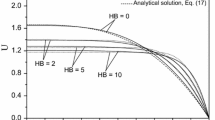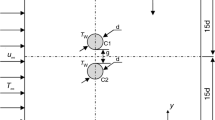Abstract
The definition of Reynolds number (Re) in a Taylor-Couette flow for a shear-thinning fluid is discussed in this paper. Since the shear-thinning property causes spatial distribution of fluid viscosity in a Taylor-Couette flow reactor (TCFR), a method to determine Re by using a numerical simulation is suggested. The effective viscosity (η eff) in Re was the average viscosity using a weight of dissipation function
where N is the total mesh number, η i (Pa·s) is the local viscosity, \( {\overset{\cdot }{\gamma}}_i \) (1/s) is the local shear-rate, and ΔV i (m3) is the local volume for each cell. The critical Reynolds number, Re cr, at which Taylor vortices start to appear, was almost the same value with the Re cr obtained by a linear stability analysis for Newtonian fluids. Consequently, Re based on η eff could be applicable to predict the occurrence of Taylor vortices for a shear-thinning fluid. In order to understand the relation between the rotational speed of the inner cylinder and the effective shear rate that resulted in η eff, a correlation equation was constructed. Furthermore, the critical condition at which Taylor vortices appear was successfully predicted without further numerical simulation.


















Similar content being viewed by others
References
Alibenyahia B, Lemaitre C, Nouar C, Ait-Messaoudene N (2012) Revisiting the stability of circular Couette flow of shear-thinning fluids. J Non-Newtonian Fluid Mech 183-184:37–51
Azaditalab M, Houshmand A, Sedaghat A (2016) Numerical study on skin friction reduction of nanofluid flows in a Taylor-Couette system. Tribol Int 94:329–335
Baumert BM, Muller SJ (1995) Flow visualization of the elastic Taylor-Couette instability in Boger fluids. Rheol Acta 34:147–159
Bird RB, Armstrong RC, Hassager O (1987) Dynamics of polymeric liquids, vol. I, fluid dynamics, 2nd edn. John Wiley & Sons, Inc., U.S.A.
Carreau PJ (1972) Rheological equations from molecular network theories. Trans Soc Rheol 16:99–127
Carreau PJ, Patterson J, Yap CY (1976) Mixing of viscoelastic fluids with helical-ribbon agitators. I—mixing time and flow patterns. Can J Chem Eng 54:135–142
Cho YI, Kensey KR (1991) Effects of the non-Newtonian viscosity of blood on flows in a diseased arterial vessel. Part 1: steady flows. Biorheology 28:241–262
Coronado-Matutti O, Souza Mendes PR, Carvalho MS (2004) Instability of inelastic shear-thinning liquids in a Couette flow between concentric cylinders. J Fluids Eng 126:385–390
Di Prima RC, Swinney HL (1981) Instabilities and transition in flow between concentric rotating cylinders, in: Hydrodynamic instabilities and the transition to turbulence, Springer-Verlag: 139–180
Dutta PK, Ray AK (2004) Experimental investigation of Taylor vortex photocatalytic reactor for water purification. Chem Eng Sci 59:5249–5259
Escudier MP, Gouldson IW, Jones DM (1995) Taylor vortices in Newtonian and shear-thinning liquids. Proc R Soc Lond A 449:155–176
Escudier MP, Poole RJ, Presti F, Dales C, Nouar C, Desaubry C, Graham L, Pullum L (2005) Observations of asymmetrical flow behavior in transitional pipe flow of yield-stress and other shear-thinning liquids. J Non-Newtonian Fluid Mech 127:143–155
Fontaine A, Guntzburger Y, Bertrand F, Fradette L, Heuzey MC (2013) Experimental investigation of the flow dynamics of rheologically complex fluids in a Maxblend impeller system using PIV. Chem Eng Res Des 91:7–17
Güzel B, Frigaard I, Martinez DM (2009) Predicting laminar-turbulent transition in Poiseuille pipe flow for non-Newtonian fluids. Chem Eng Sci 64:254–264
Hubacz R, Buczyńska M (2011) Starch gelatinization in Couette-Taylor flow apparatus. Chem Process Eng 32:267–279
Hubacz R, Ohmura N, Dluska E (2013) Intensification of processing using apparatus with Couette-Taylor flow. J Food Process Eng 36:774–785
Hwang JY, Yang KS (2004) Numerical study of Taylor-Couette flow with an axial flow. Comput Fluids 33:97–118
Jastrzębski M, Zaidani HA, Wroński S (1992) Stability of Couette flow of liquids with power law viscosity. Rheol Acta 31:264–273
Jenny M, Plaut E, Briard A (2015) Numerical study of subcritical Rayleigh-Bénard convection rolls in strongly shear-thinning Carreau fluids. J Non-Newtonian Fluid Mech 219:19–34
Kaminoyama M, Nishi K, Misumi R, Otani F (2011) A method for determining the representative apparent viscosity of highly viscous pseudoplastic liquids in a stirred vessel by numerical simulation. J Chem Eng Jpn 44:868–875
Kataoka K, Doi H, Hongo T, Futagawa M (1975) Ideal plug-flow properties of Taylor vortex flow. J Chem Eng Jpn 8:472–476
Kataoka K, Ohmura N, Kouzu M, Simamura Y, Okubo M (1995) Emulsion polymerization of styrene in a continuous Taylor vortex flow reactor. Chem Eng Sci 50:1409–1416
Kozicki W, Chou CH, Tiu C (1966) Non-Newtonian flow in ducts of arbitrary cross-sectional shape. Chem Eng Sci 21:665–679
Larson RG, Shaqfeh ESG, Muller SJ (1990) A purely elastic instability in Taylor-Couette flow. J Fluid Mech 218:573–600
Lee S, Lueqtow RM (2001) Rotating reverse osmosis: a dynamic model for flux and rejection. J Memb Sci 192:129–143
Lockett TJ, Richardson SM, Worraker WJ (1992) The stability of inelastic non-Newtonian fluids in Couette flow between concentric cylinders: a finite-element study. J Non-Newtonian Fluid Mech 43:165–177
Makino T, Kaise T, Sasaki K, Ohmura N, Kataoka K (2001) Isolated mixing region in a Taylor-vortex-flow reactor. Kagaku Kogaku Ronbunshu 27:566–573
Masuda H, Horie T, Hubacz R, Ohmura N (2013) Process intensification of continuous starch hydrolysis with a Couette-Taylor flow reactor. Chem Eng Res Des 91:2259–2264
Masuda H, Horie T, Hubacz R, Ohta M, Ohmura N (2015) Numerical analysis of the flow of fluids with complex rheological properties in a Couette-Taylor flow reactor. Theo Appl Mech Japan 63:25–32
Matsumoto K, Ohta M, Iwata S (2015) Numerical analysis of flow dynamics of milk in a milk-filling process. Kagaku Kougaku Ronbunshu 41:1–10
Metzner AB, Otto RE (1957) Agitation of non-Newtonian fluids. AICHE J 3:3–10
Metzner AB, Reed JC (1955) Flow of non-Newtonian fluids-correlation of the laminar, transition and turbulent-flow regions. AICHE J 1:434–440
Michele J, Patzold R, Donis R (1977) Alignment and aggregation effects in suspensions of spheres in non-Newtonian media. Rheol Acta 16:316–321
Muller SJ, Larson RG, Shaqfeh ESG (1989) A purely elastic transition in Taylor-Couette flow. Rheol Acta 28:499–503
Nemri M, Climent E, Charton S, Lanoë JY (2013) Experimental and numerical investigation on mixing and axial dispersion in Taylor–Couette flow patterns. Chem Eng Res Des 91:2346–2354
Niederkorn TC, Ottino JM (1994) Chaotic mixing of shear-thinning fluids. AICHE J 40:1782–1793
Orlowska M, Koutchma T, Kostrzynska M, Tang J, Defelice C (2014) Evaluation of mixing flow conditions to inactivate Escherichia coli in opaque liquids using pilot-scale Taylor-Couette UV unit. J Food Eng 120:100–109
Pakdel P, McKinley GH (1996) Elastic instability and curved streamlines. Phys Rev Lett 77:2459–2462
Parmentier EM (1978) A study of thermal convection in non-Newtonian fluids. J Fluid Mech 84:1–11
Patel VR, Ein-Mozaffari F, Upreti SR (2011) Effect of time delays in characterizing the continuous mixing of non-Newtonian fluids in stirred-tank reactors. Chem Eng Res Des 89:1919–1928
Poole RJ, Escudier MP (2004) Turbulent flow of viscoelastic liquids through an axisymmetric sudden expansion. J Non-Newtonian Fluid Mech 117:25–46
Ramezani M, Kong B, Gao X, Olsen MG, Vigil RD (2015) Experiment measurement of oxygen mass transfer and bubble size distribution in an air-water multiphase Taylor-Couette vortex bioreactor. Chem Eng J 279:286–296
Saeed S, Ein-Mozaffari F (2008) Using dynamic tests to study the continuous mixing of xanthan gum solutions. J Chem Technol Biotechnol 83:559–568
Sczechowski JG, Koval CA, Noble RD (1995) A Taylor vortex reactor for heterogeneous photocatalysis. Chem Eng Sci 50:3163–3173
Shaqfeh ESG, Muller SJ, Larson RG (1992) The effects of gap width and dilute solution properties on the viscoelastic Taylor-Couette instability. J Fluid Mech 235:285–317
Sinevic V, Kuboi R, Nienow AA (1986) Power numbers, Taylor numbers and Taylor vortices in viscous Newtonian and non-Newtonian fluids. Chem Eng Sci 41:2915–2923
Sobolík V, Izrar B, Lusseyran F, Skali S (2000) Interaction between the Ekman layer and Couette-Taylor instability. Int J Heat Mass Trans 43:381–4393
Sulivan TM, Middleman S (1986) Film thickness in blade coating of viscous and viscoelastic liquids. J Non-Newtonian Fluid Mech 21:13–38
Taylor GI (1923) Stability of a viscous liquid contained between two rotating cylinders. Phil Trans Roy Soc A 223:289–343
White JM, Muller SJ (2002) Experimental studies on the stability of Newtonian Taylor-Couette flow in the presence of viscous heating. J Fluid Mech 462:133–159
Yap CY, Patterson WI, Carreau PJ (1979) Mixing with helical ribbon agitators: part III non-Newtonian fluids. AICHE J 25:516–521
Yasuda K, Armstrong RC, Cohen RE (1981) Shear flow properties of concentrated solutions of linear and star branched polystyrenes. Rheol Acta 20:163–178
Author information
Authors and Affiliations
Corresponding author
Rights and permissions
About this article
Cite this article
Masuda, H., Horie, T., Hubacz, R. et al. Prediction of onset of Taylor-Couette instability for shear-thinning fluids. Rheol Acta 56, 73–84 (2017). https://doi.org/10.1007/s00397-016-0987-7
Received:
Revised:
Accepted:
Published:
Issue Date:
DOI: https://doi.org/10.1007/s00397-016-0987-7




